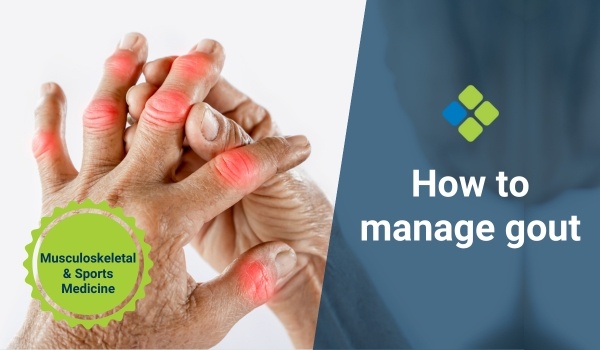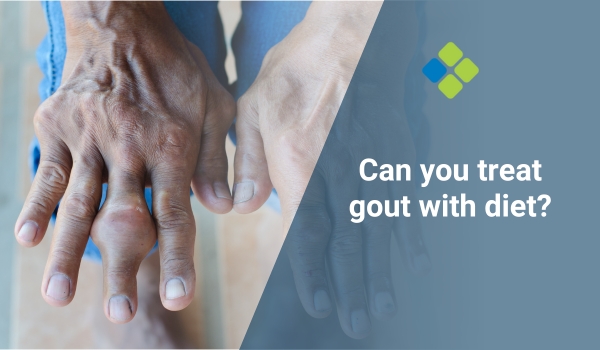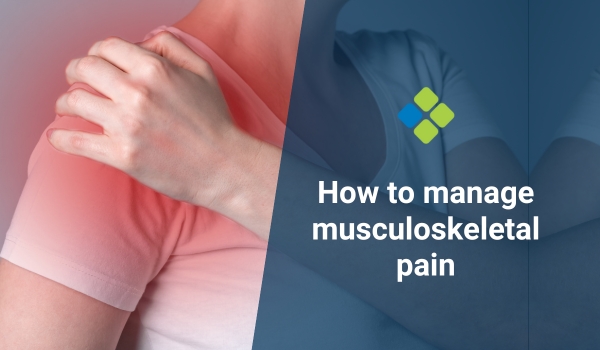How to manage gout
Read about the characteristics, manifestations, and management of gout to better manage symptoms and minimise the incidence of attacks in your patients.

HealthCert Education
Gout is an acquired form of arthritis that can be well managed with lifestyle modifications, regular exercise, and dietary changes. As most patients with gout have comorbidities, an interprofessional healthcare approach is required to successfully manage the symptoms of gout and minimise the incidence of attacks.
What is gout?
Gout is an inflammatory condition that affects small joints. It is caused by a high level of uric acid (hyperuricemia). The incidence of gout is increasing, with 95.8 million individuals expected to be affected by 2050. Gout predisposes patients to inflammatory arthritis by subcutaneous or juxta-articular deposition of monosodium urate (MSU) monohydrate crystals. The first signs of gout are hyperuricemia and uricosuria. The abnormally high urate crystals lead to renal calculus formation.
Gout typically affects more men compared to women, with a ratio of 3:1. Although gout is prevalent in older age, the gap has significantly narrowed with the rise of non-communicable diseases.
Clinical characteristics of gout
Gout is episodic in nature with infrequent intervals. Although many individuals remain non-tophaceous, recurrent episodes of acute attacks trigger inflammatory arthritis. The patient experiences sudden, intense night pain, swelling, and redness in small joints, especially big toes, knees, and fingers - i.e. peripheral joint synovitis. Gout first affects the lower limb, resulting in restricted joint movement due to pain. Gout also affects the bursa and tendon sheaths, causing lingering discomfort for days.
There are four phases of gout:
- Asymptomatic gout
- Acute gout
- Interval gout
- Chronic tophaceous gout
Clinical manifestations of gout
Gout flares are associated with a high rate of cardiovascular events (acute myocardial infarction [MI] and Stroke). The prevalence of cardiovascular disease in those affected with gout is 2 to 3 times higher. According to research literature based on US data, 74% of individuals with gout have hypertension, 14% have MI, and 11% are at risk of heart attack.
Long-term effects of gout cause chronic/irreversible comorbidities, including metabolic disorders (diabetes, osteoporosis), and genitourinary, neurological, and rheumatological disorders.
Management of gout
The aetiology of gout depends on both modifiable and non-modifiable risk factors. Although epidemiological and genetic factors are non-modifiable, amendable changes in diet, BMI, and medications can improve urate levels and minimise the incidence of gout flare episodes.
Lifestyle modifications
Dietary changes
Research literature shows that purine-rich foods, particularly red meat, increase uric acid levels. It reduces the urine output. The concentrates of uric acid crystals decrease the mean urine excretion. The saturated fat in purine-rich foods causes insulin resistance and increases low lipoprotein cholesterol, leading to diabetes, peripheral neuropathy, and cardiovascular diseases.
The clinical recommendations by Harvard suggest staying hydrated and eating a diet rich in whole grain foods, plant-based oils, vegetables, fruits, nuts, legumes, and eggs or poultry meat occasionally.
Body weight management
Abnormal weight gain due to unhealthy dietary intake is associated with high levels of uric acid. Central obesity has a close association with type 2 diabetes, peripheral vascular diseases, renal diseases, and hyperuricemia.
Research has shown that a decrease in weight significantly decreases serum urate levels in blood. Maintaining a healthy weight under BMI controls uric acid levels. It also reduces the recurrent episodes of gout.
Pharmacological management
There are certain medications linked with chronic conditions that cause increased levels of uric acid in the blood. Such medications include diuretics, aspirin, niacin, and cyclosporine. These drugs are prescribed to treat long-term cardiovascular and autoimmune diseases. However, their adverse effects can cause secondary complications leading to hyperuricemia and gout. Changes in the dosage of these medications help to reduce uric acid levels.
A multifaceted approach is used to treat and manage gout symptoms. The universally recommended treatment by ACR, the British Society of Rheumatology, and EULAR recommends treatment to target serum urate. This involves flare therapy, long-term ULT, patient education, illness monitoring, and comorbidity management. NSAIDs, corticosteroids, and colchicine are first-line anti-inflammatory treatments for gout flares.
Conservative management
Physiotherapy is used to treat a symptom approach. It aims to increase joint range of motion, pain management, reduce stiffness, and strengthen weakened muscles.
- Dr Humda, Physiotherapist
References
- https://www.thelancet.com/journals/lanrhe/article/PIIS2665-9913(24)00117-6/fulltext
- https://www.sciencedirect.com/science/article/pii/S0049017220301220
- https://jamanetwork.com/journals/jama/article-abstract/2794763
- https://www.sciencedirect.com/science/article/abs/pii/S0002934312001891
- https://link.springer.com/article/10.1186/s13098-024-01268-1
- https://www.sciencedirect.com/science/article/abs/pii/S0002934318311343
- https://www.academia.edu/download/103284670/GOUT.pdf
Learn more about this topic in the HealthCert Professional Diploma program in Musculoskeletal & Sports Medicine - fully online or with optional practical workshops.
Engaging with this blog can help meet your annual
|
|
If you consume educational webinars, podcasts, articles, or research on this blog, you can Quick Log CPD hours with the RACGP via the usual self-submission process. You will be asked to reflect on what you have learned, and you will require supporting evidence such as a screenshot. |

 1800 867 1390
1800 867 1390







